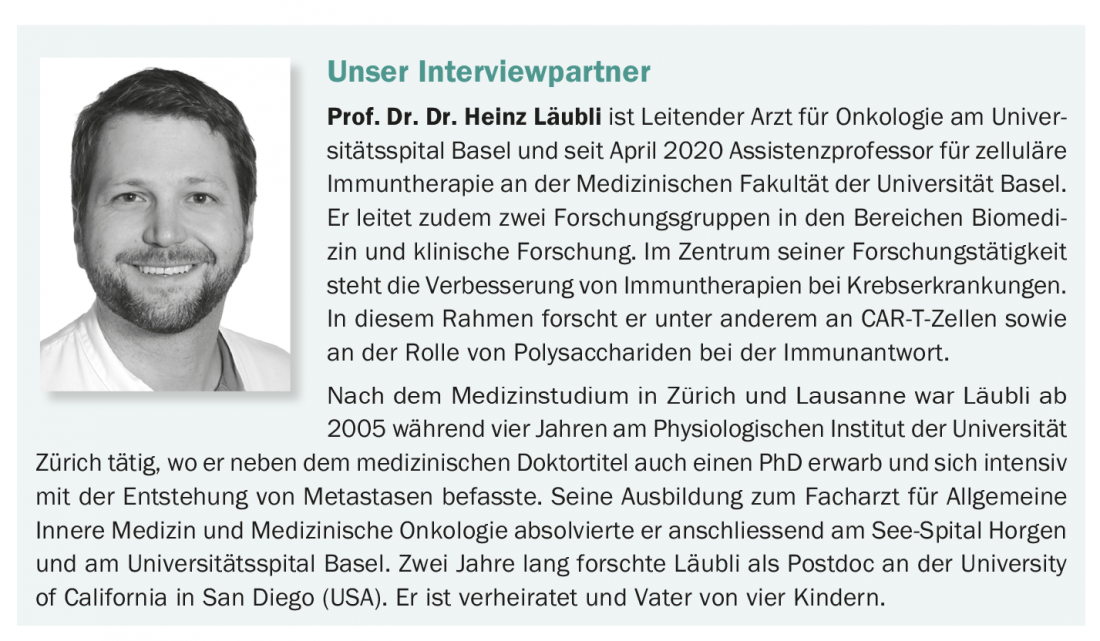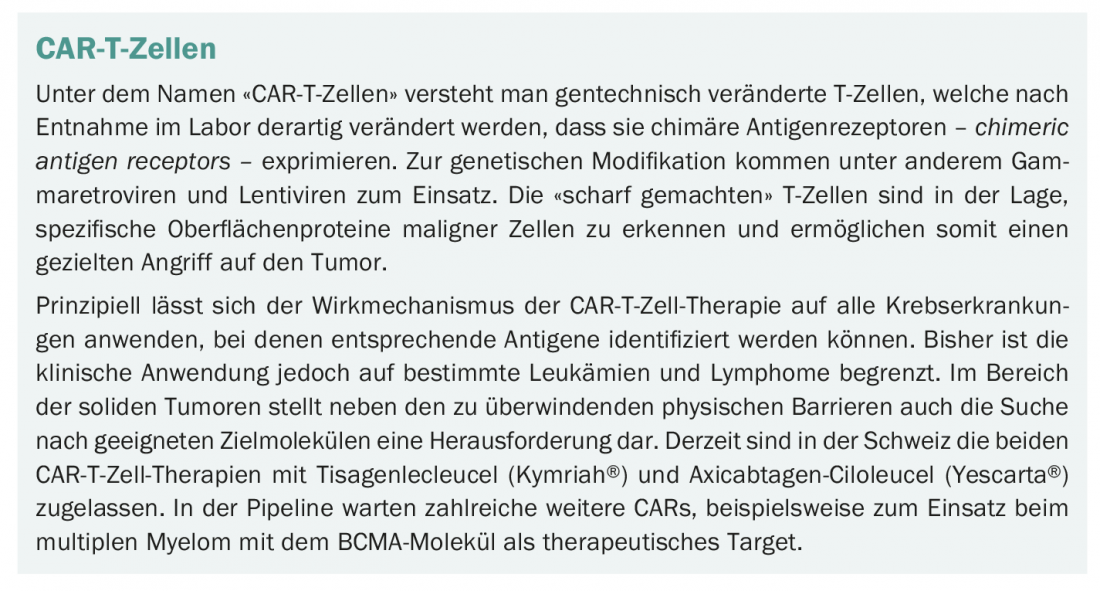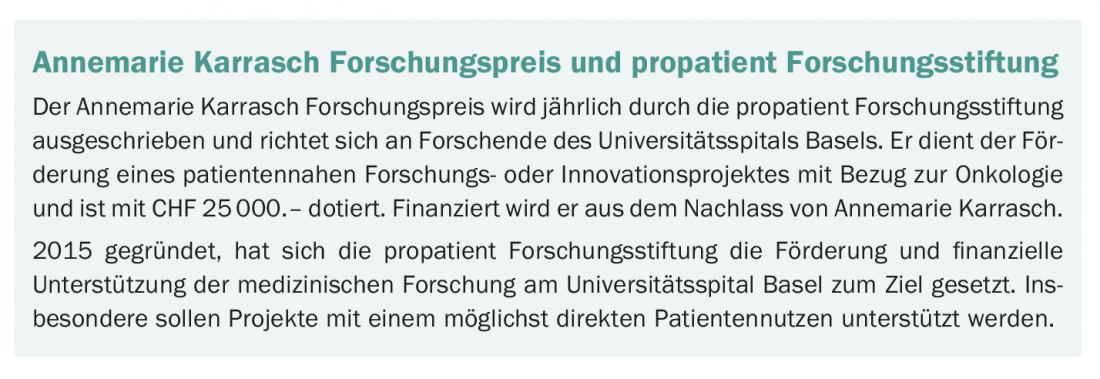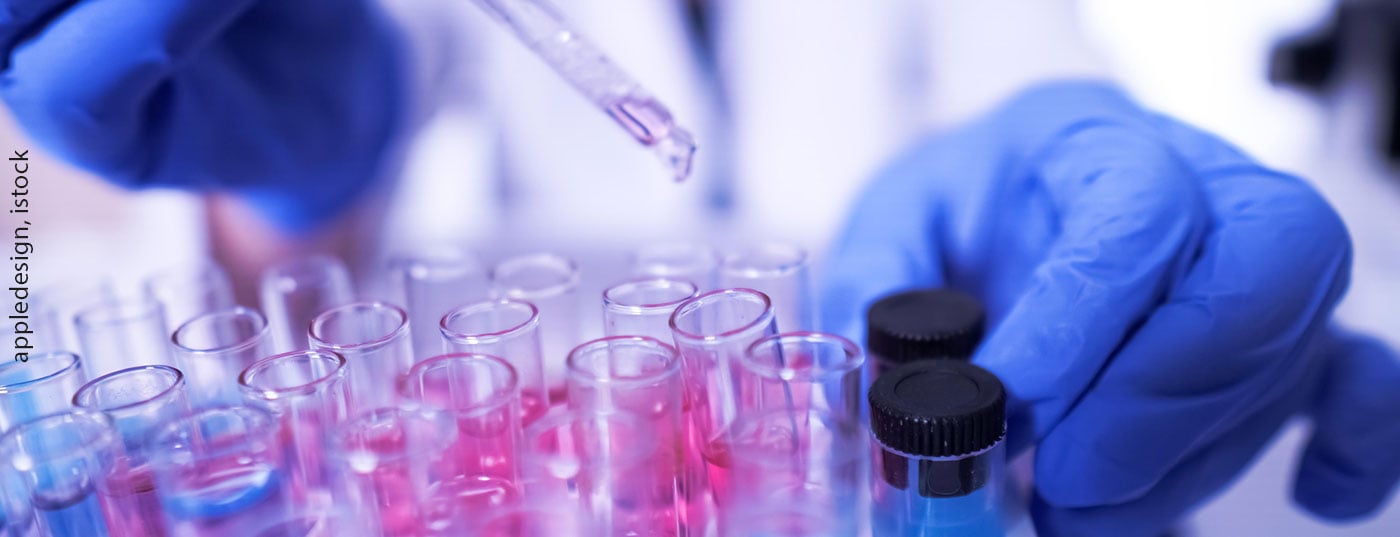Recently, Prof. Dr. Dr. Heinz Läubli, Head Physician for Oncology at the University Hospital Basel, received this year’s Annemarie Karrasch Research Award of the Basel Research Foundation propatient. Läubli’s research includes the use of CAR-T cells in solid tumors. We talked to him about his projects, his motivation and current developments in oncology.
Congratulations on the research award! The project, which was awarded by the propatient foundation, is about CAR-T cells, cellular immunotherapy. Can you briefly explain your research?
Heinz Läubli: CAR-T cells have become established in the field of hematological neoplasms in recent years, both in B-cell lymphoma and plasma cell neoplasms. These applications contrast with use in solid tumors, where the methodology is not currently implemented. A major goal of our research group is to be able to launch our own projects to investigate the therapy of solid tumors using CAR-T cells.
For this specific project, we have teamed up with PD Dr. med. Ulf Petrausch and Prof. Dr. med. Christoph Renner (editor’s note: OnkoZentrum Zürich, Hirslanden). In collaboration with PD Dr. med. Alessandra Curioni (editor’s note: University Hospital Zurich), the two had already initiated a study and treated three mesothelioma patients with the same CAR-T cells that are now being used in our project. These CAR-T cells target fibroblast activation protein (FAP), which is commonly expressed by solid tumors. We now plan to treat additional patients with immunohistochemically proven FAP expression. In contrast to the previous project in mesothelioma, we will also measure the FAP expression of fibroblasts, and not only that of tumor cells. The goal is to then apply the CAR-T cells directly into the lesion, i.e., to inject them into the tumor in an ultrasound-guided manner. This is because FAP is also increasingly expressed in other diseases, especially when inflammation and scarring are involved. An example of this is myocardial infarction. This naturally leads to certain security concerns. Due to these safety concerns, the FAP-CARs – i.e. the CAR-T cells directed against FAP – were already applied directly into the tumor in the mesothelioma study and only in very small doses. We also want to take a close look at dose, and one focus will be to examine dose increases.
The trial that has already taken place, although manageable, allows us to start already with a better level of knowledge. Many safety concerns have been mitigated by the previous study and the external production of the FAP-CAR-T cells by Biontech has been proven. This is done using lentiviruses, which are also used in the generation of the established anti-CD-19 CAR-T cell product Kymriah®.

The production of CAR-T cells is always a topic of discussion, not only because of the high costs, but also, for example, because of the long transport routes involved in external production. Do you think production by university hospitals and research institutions is a realistic and goal-oriented option?
In fact, it is very close to my heart that we manage to produce CAR-T cells ourselves in academic laboratories. However, not to compete with pharmaceutical companies. My particular concern here is to simplify research with CAR-T cells and, in many cases, to make it possible in the first place. Lentiviral production is extremely expensive. Depending on the production site, we have to expect costs of half a million to two million Swiss francs for five to six patients – a major obstacle for academic research. To counter this, we are currently working with a German laboratory in Würzburg. Our common goal is to be able to independently produce and further develop CAR-T cells for research purposes. The production of these CAR-T cells is not based on the use of lentiviruses, but on electoporation. This method is not cheaper in the development of new CAR-T cell products, but one can treat ten to twenty times more patients for the same price. The costs per patient are therefore significantly lower. Once a construct is in place, this can be used more favorably in various studies.
However, I do not see this option, which I hope we will soon be able to implement, as being in any way in competition with the industrial production of CAR-T cells. Rather, production in academic laboratories is, in my opinion, a good complement to the commercial offer, especially in the area of studies. Where the pharmaceutical industry has established safe manufacturing, it doesn’t make sense for me to want to get in on the action, too. Ensuring safety at large production facilities is extremely difficult given the complex processes involved. In addition, as an academic institution, it would probably be a major challenge to obtain appropriate marketing approvals for CAR-T cells, which are considered a drug. For each individual product, at least one phase II study would have to be conducted to demonstrate efficacy. In my opinion, these efforts would miss the mark by a long way. My goal is much more to establish a pipeline for the realization of my own projects in the Basel area in cooperation with the university and the university hospital. This would make it easier and more affordable to test exciting targets validated in animal models in humans. In this framework, production in academic laboratories could even strengthen collaboration with industrial partners, because promoting innovation also creates new investment opportunities.
The disadvantage of long transport distances could be counteracted with new production equipment, which is already in use at some clinics. These enable the production of CAR-T cells at diverse sites. One example is the CliniMACS Prodigy from Miltenyi Biotec. However, this option should also be done in close cooperation with someone who ensures the maintenance of the equipment and guarantees the safety of production. Decentralized production is therefore also possible in cooperation with industrial suppliers.
In the whole discussion, we should not forget that the bottom line is to make the best possible cancer treatment available to as many patients as possible. Also in the area of novel therapies. The goal must therefore be to exploit synergies with industrial partners and to develop complementary offerings. I am thinking, for example, of the production of CD-19 tandem CAR-T cells in cases of resistance or the use in patients with CD-19-associated malignancies, for which neither Kymriah® nor Yescarta® are approved. These sufferers can be helped within the framework of studies. This accessibility is an important reason for me as an oncologist to push for the production of CAR-T cells by academic laboratories, in addition to research funding and the anchoring of cellular therapies in the Basel area.

Bottom line: How do you assess the potential of CAR-T cells?
In the field of hematologic neoplasms, it is relatively clear that CAR-T cells already represent an important component of therapy that will grow in the future. Many studies are underway there, including for use in earlier lines of therapy. However, there is still uncertainty about the role of genetically modified cells in the treatment of solid tumors. I think intensive research in this area is very important.
In particular, naturally occurring, i.e. non-genetically modified, T cells could be increasingly used in the future. Similar to the CHUV (ed.: Centre hospitalier universitaire vaudois), we have already successfully treated patients with solid tumors with TILs (ed.: tumor-infiltrating lymphocytes).). In our TIL program, the third patient with metastatic melanoma will soon receive appropriate therapy. So far, we have observed an extremely good response, despite proven resistance to any alternative treatment options. Especially in such situations, in the absence of other options, I think that cellular therapies will also play an important role in the treatment of solid tumors in the future. However, it is still too early to judge whether these will be primarily CAR T cells or naturally occurring T cells. Certainly it would be wrong not to do research in this area. I am convinced that if we admit defeat now and leave the research to renowned institutions such as the NKI (editor’s note: Netherlands Cancer Institute) in Amsterdam or the CHUV, we miss the opportunity to make a valuable contribution and help patients with advanced oncological diseases.
Of course, there are alternative concepts such as bispecific antibodies, which are much simpler to use. These can be administered as a drug and do not require individual preparation. Universal CARs, which are produced in batches, could also become more important in the future. These are all valid and extremely exciting approaches that need to be examined in more detail. In which direction it will eventually go remains to be seen. I can’t give a more precise forecast on FAP as a target yet either. The protein is expressed relatively specifically on tumors, but whether it is safe to attack using CAR-T cells is simply not yet assessable.
What are the biggest challenges in the development of CAR-T cells in the coming years?
In addition to the enormous production costs, identifying the optimal production method is also a major challenge. At present, upscaling (editor’s note: increasing production) is not technically straightforward. There are a variety of approaches here, which represent good opportunities for improving genetic manipulation. The goal is to achieve as specific a change as possible, for example by knocking out the T cell receptor locus and replacing it with a gene encoding the chimeric antigen receptor.
Also, the immunogenicity of CAR-T cells needs to be further investigated in the future. In the infancy of new CAR development, safety is still the primary concern, and just like any other foreign material, CAR T cells can potentially trigger immune responses. These can cause side effects on the one hand and weaken the effect on the other. Strategies to manage adverse effects such as cytokine release syndrome and CNS toxicity still need to be improved over the coming years. In the area of solid tumors, it is also a matter of identifying good targets in the near future and preventing a loss of effect of CAR-T cells during the course of therapy.
Larotrectinib was the first entity-independent agent to be approved in Switzerland in 2020. What are your assessments and hopes for regulatory policy changes in the coming years?
In my experience, Swissmedic is very open to broad testing of new products. It is clear that certain requirements must be met. The situation is somewhat different in terms of market registrations. Tumor-specific applications are still the standard here today, and this is unlikely to change over the next few years. In my opinion, there will continue to be approvals primarily for those tumor entities that have also been included in studies. Approvals for malignancies where use has not been evaluated are more likely to be critical. The difficulty lies mainly in the identification of suitable markers. Markers that work for one entity are not necessarily transferable to other diseases. A good example of this is the BRAF mutation, which acts as a driver and thus a therapeutic target in certain tumors and not in others. Similarly, no universally applicable predictive biomarker exists for checkpoint inhibitor therapy to select appropriate patients across different tumor entities. Even if pembrolizumab is approved for tumor diagnosis in the U.S., determination of tumor mutational burden does not reliably predict response.
It is quite conceivable that there will not be randomized phase III trials for every entity, but some testing of efficacy in trials will, in my view, continue to be necessary in the future for a compound to be covered. In view of the heterogeneous tumor biology, I also consider this approach to be reasonable.
Already today, many pivotal trials are no longer classic randomized phase III trials. Where is the journey heading?
Especially in the field of targeted therapies and also in cellular treatments, the development is moving towards efficiency studies. However, there are significant differences here depending on the line of therapy. Understandably, the more hopeless the situation and the fewer alternatives already on the market, the more likely approval is based on thinner data. Also, recruitment for trials in advanced tumor stages is more difficult because there are simply fewer patients. If approval is sought for early lines of therapy where established standard therapies already exist, randomized trials will continue to be necessary. The decisive factor for the evaluation is therefore in particular the medical need. If this is high and studies are difficult to conduct – as is the case with cellular treatments – approval is more likely based on promising efficacy data from single-arm phase II trials.
Is Switzerland as a research location a disadvantage due to its small size and thus more difficult recruitment?
I think Switzerland can score points in an international comparison because of the extremely high quality of its studies. Compared to other countries like Spain or Italy with highly centralized healthcare systems, we are certainly at a bit of a disadvantage logistically and in terms of recruitment. But I think we know how to deal with this disadvantage and more than make up for it with high scientific activity at the individual centers. A plus point with us is the large number of studies, which are the result of input from researchers and contribute a great deal to the diversity of the study landscape. To be able to implement one’s own study interests in the academic setting is something I feel is extremely important for the development of research and innovation in a country. After all, this is what makes the translation of preclinical research into the clinic possible in the first place. Providing appropriate structures should be a high priority at university hospitals. This is well implemented in Switzerland and contributes significantly to the fact that we are also able to hold our own in international comparison. It also encourages investment.
They were in the U.S. for research in 2012 through 2014 and again in 2019. To what extent have these stays shaped your scientific and also clinical career?
From 2012 to 2014, I was in a laboratory-only setting, which was extremely relevant to my translational basic research. We are also currently conducting intensive research on glycan alterations of the tumor. I brought this research orientation in the field of basic research with me from the USA. I was also able to build up a good network during my research stay and acquire various skills that are needed in the lab. I find it very exciting to track projects that we started in a preclinical setting back then to today. For example, there is now a company that produces sialidase and hopes to conduct the first clinical trials this year (editor’s note: treating T cells with sialidase is expected to increase their resistance to inactivation by the tumor). Clinically, my time in the U.S. was formative in that the first checkpoint inhibitors emerged at that time.
In 2019, I was at Stanford as part of cell therapy research. A very active CAR-T cell program is underway there. I have seen that with an appropriate focus, very attractive conditions can be created for hospitals. The insight has shown us that investments in this area are well worthwhile – especially for the care of patients with hematological neoplasms such as lymphomas. Here, too, strong collaboration between industry and university hospitals is needed. In Switzerland, the situation is that a large number of clinics will offer anti-CD-19 CAR T-cell therapies and also CAR T-cell therapies in multiple myeloma. That worries me a little bit, because it does take a certain number of patients to gather expertise and make investments for the best possible infrastructure.
Research activity runs through your career from the beginning. What is your biggest motivation for doing this?
A big motivation is certainly that I find the combination of research and clinical work extremely exciting. On the one hand I see the medical need and on the other hand the feasibility in the laboratory. There are brilliant researchers who have spent their lives in the laboratory. They can certainly implement certain things, especially technical things, better than I can. Nevertheless, I am convinced that regular patient contact brings a lot of positive aspects to one’s own research activities. Another motivation lies in the possibility of improving patient outcomes. Cellular therapies in particular, for example, often involve young melanoma patients who would otherwise die. And giving these people access to life-saving therapies is something that drives me a lot.
It’s also the case that as an oncologist, as a physician in general, you experience a lot of suffering. I think that’s where it’s helpful for your own life to build a certain balance between that suffering and positivity. Of course, everyone must know for himself or herself how he or she wants to do it. There are colleagues who work 80% and perhaps pursue a hobby intensively. For me, this balance is research.

Key point: You are a senior physician, are very active in research, and have a large family. This quickly exceeds regular stints. How do you handle the workload? How do you set your priorities?
A big advantage is that once you reach a certain position, you can manage your clinical work much better. The research professorship gives me relatively great freedom. Being able to plan yourself helps enormously. Also in the process of giving similar weighting to the individual areas of life. Of course, the job is important, but in the meantime it is possible for me to pick up a child from soccer practice at six o’clock. Of course, that’s harder when you’re on late-night and night duty in the emergency department. Fortunately, this phase is usually temporary. For me, after that time, it was quite liberating to be able to have some influence on the planning myself.
I have also learned over time to distinguish the important from the less important. Reports can still be written the day after tomorrow. As long as patient care and good handovers are guaranteed, one may prefer other things. Not every letter has to be five pages long, for which the family doctor then again has no time.
In research, it is enormously important to work with independent people and to allow them to be independent. Fortunately, I can pass on a large part of my work to extremely capable employees. So today I don’t find it so difficult to reconcile everything. The pandemic even made that a little easier, since all travel was eliminated. I clearly noticed how much time you can save by not having to fly to the US.
The interview took place via video call on March 9, 2021. It was conceived and carried out by Amelie Stüger.
InFo ONCOLOGY & HEMATOLOGY 2021; 9(2): 16-19.












